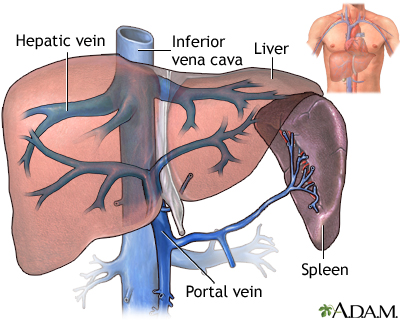Distal splenorenal shunt
DSRS; Distal splenorenal shunt procedure; Renal - splenic venous shunt; Warren shunt; Cirrhosis - distal splenorenal; Liver failure - distal splenorenal; Portal vein pressure - distal splenorenal shunt
A distal splenorenal shunt (DSRS) is a type of surgery done to relieve extra pressure in the portal vein. The portal vein carries blood from your digestive organs to your liver.
Images

I Would Like to Learn About:
Description
During DSRS, the vein from your spleen is removed from the portal vein. The vein is then attached to the vein to your left kidney. This helps reduce blood flow through the portal vein.
Why the Procedure Is Performed
The portal vein brings blood from the intestine, spleen, pancreas, and gallbladder to the liver. When blood flow is blocked, the pressure in this vein becomes too high. This is called portal hypertension. It often occurs due to liver damage caused by:
- Alcohol use
- Chronic viral hepatitis
- Blood clots
- Certain congenital disorders
- Primary biliary cirrhosis (liver scarring caused by blocked bile ducts)
When blood can't flow normally through the portal vein, it takes another path. As a result, swollen blood vessels called varices form. The most important location for these is in the esophagus. They develop thin walls that can break and bleed into the esophagus and stomach.
You may have this surgery if imaging tests such as upper GI endoscopy or x-rays show that you have bleeding varices in the esophagus or stomach. DSRS surgery reduces pressure on the varices and helps control bleeding.
Risks
Risks for anesthesia and surgery in general are:
- Allergic reactions to medicines or breathing problems
- Bleeding, blood clots, or infection
Risks of this surgery include:
- Buildup of fluid in the belly (ascites)
- Repeat bleeding from the varices
- Encephalopathy (loss of brain function because the liver is unable to remove toxins from the blood)
Before the Procedure
Before the surgery, you may have certain tests:
- Angiogram (to view inside the blood vessels)
- Blood tests
- Upper GI endoscopy
Give your health care provider a list of all the medicines you take including prescription and over-the-counter, herbs, and supplements. Ask which ones you need to stop taking before the surgery, and which ones you should take the morning of the surgery.
Your provider will explain the procedure and tell you when to stop eating and drinking before the surgery.
After the Procedure
Expect to stay 7 to 10 days in the hospital after surgery to recover.
When you wake up after the surgery you will have at least one or more of the following:
- A tube in your vein (IV) that will carry fluid and medicine into your bloodstream
- A catheter in your bladder to drain urine
- An NG tube (nasogastric) that goes through your nose into your stomach to remove gas and fluids
- A pump with a button you can press when you need pain medicine
As you are able to eat and drink, you will be given liquids and food.
You may have an imaging test to see if the shunt is working.
You may meet with a dietitian, and learn how to eat a low-fat, low-salt diet.
Outlook (Prognosis)
After DSRS surgery, bleeding is controlled in most people with portal hypertension. The highest risk of bleeding again is in the first month after surgery.
References
Dudeja V, Ferrantella A, Fong Y. The liver. In: Townsend CM Jr, Beauchamp RD, Evers BM, Mattox KL, eds. Sabiston Textbook of Surgery. 21st ed. St Louis, MO: Elsevier; 2022:chap 54.
Weeks SR, Ottmann SE, Orloff MS. Portal hypertension: role of shunting procedures. In: Cameron JL, Cameron AM, eds. Current Surgical Therapy. 13th ed. Philadelphia, PA: Elsevier; 2020:387-389.
BACK TO TOPReview Date: 8/22/2022
Reviewed By: Debra G. Wechter, MD, FACS, General Surgery Practice Specializing in Breast Cancer, Virginia Mason Medical Center, Seattle, WA. Also reviewed by David C. Dugdale, MD, Medical Director, Brenda Conaway, Editorial Director, and the A.D.A.M. Editorial team.

Health Content Provider
06/01/2025
|
A.D.A.M., Inc. is accredited by URAC, for Health Content Provider (www.urac.org). URAC's accreditation program is an independent audit to verify that A.D.A.M. follows rigorous standards of quality and accountability. A.D.A.M. is among the first to achieve this important distinction for online health information and services. Learn more about A.D.A.M.'s editorial policy, editorial process and privacy policy. A.D.A.M. is also a founding member of Hi-Ethics. This site complied with the HONcode standard for trustworthy health information from 1995 to 2022, after which HON (Health On the Net, a not-for-profit organization that promoted transparent and reliable health information online) was discontinued. |
The information provided herein should not be used during any medical emergency or for the diagnosis or treatment of any medical condition. A licensed medical professional should be consulted for diagnosis and treatment of any and all medical conditions. Links to other sites are provided for information only -- they do not constitute endorsements of those other sites. © 1997- 2024 A.D.A.M., a business unit of Ebix, Inc. Any duplication or distribution of the information contained herein is strictly prohibited.
